This is going to be a (far too abbreviated) article about the great paintings of a man that the world has seemingly forgotten. Which is a shame. But it is also something else as well. For I am going to get really, and absolutely personal about art and what it means to me, and about the United States as well.
You see, and must understand, art is a creation that massages our emotions. If that art generates good thoughts, or treasured memories within us, it becomes priceless and valuable. But consider what would happen if somehow an evil person is able to take that treasured moment away from you. What then?
Thus this post.
The artist that we shall discuss is one of my all-time favorites. His name was William Adolphe Bouguereau, and I had the opportunity to see his works up front and close up in the Carnegie Mellon museum of art in Oakland, Pennsylvania (It’s an upscale suburb of Pittsburgh.)
And while he is no longer popular or appreciated in Art History class, his works and the emotions that they generate lives on through MM.
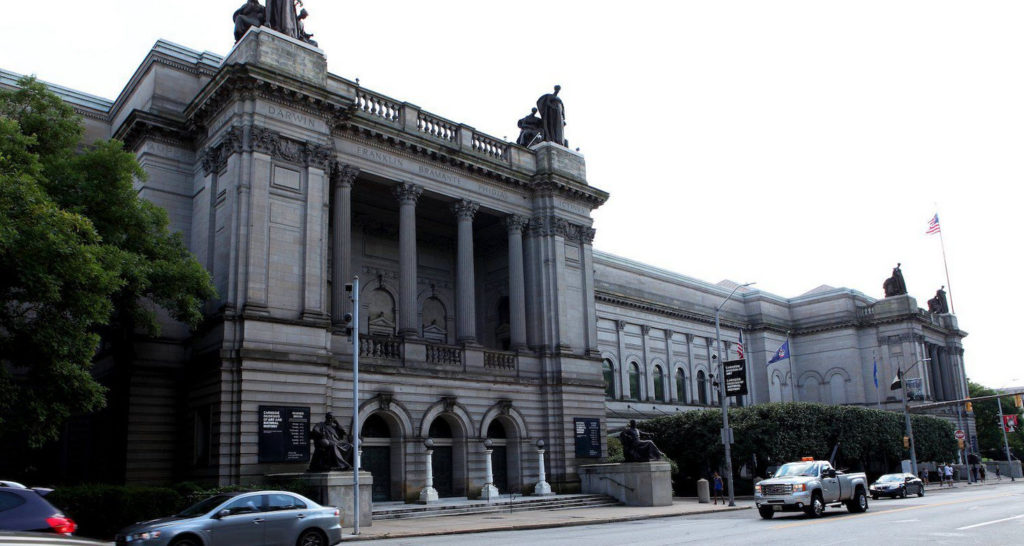
Indeed, he is not forgotten here.
Fundamentally, William Adolphe Bouguereau was a most amazing painter. And while his paintings inspire and astound, when you look at his works up close, you wonder just how in the world was he able to do what he did. Up close, everything just seems to be dabs and drabs of paint here and there.
You can well imagine him put a drop here, and then a drop there, and then somehow, by some miracle it all comes together in an amazing work of art.
He is considered to be a “French Academic Classical painter, teacher, frescoist and draftsman”. He died in 1905 after 432 amazing works of art.
To see a complete collection of his works you can visit the Art Renewal Center here. Prepare to be stunned and amazed. (Pssst. You can also order prints of his works there to put up in your house or favored spot. - Just a thought. Don't you know.)
What I really want to say about this is that beauty surrounds us everywhere.
And if you have an opportunity, take an afternoon with friends or family and visit an Art museum, and then have a nice lunch. Go out. Have fun. Enjoy life. And if by chance you ever get the chance to see any Academic Classic paintings, by all means go forth and enjoy.
Check out his amazing works.
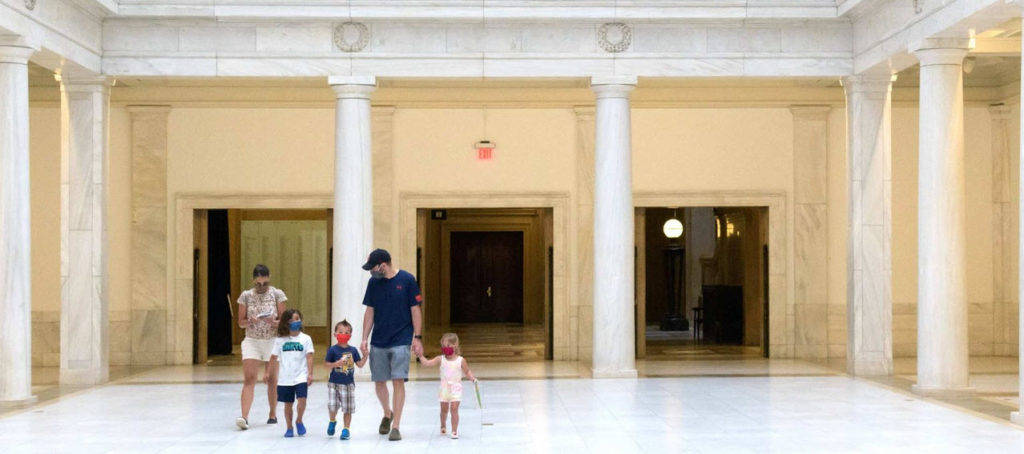
…
Sigh.
And now the sad part of the story.
I strongly love art for the emotions, the memories and the images that they represent to me on a very personal and visceral basis. While I have never been able to match the mastery of the oils as these Masters have, they have inspired me. And I have taken on my own efforts to pain figurative and allegorical works of my own design. And I like to think of myself as “pretty good”, I would only rate a “7” compared to the Master that is listed herein. Who is, in every way, a “10+”.
Up until my arrest (as part of my “retirement” from the MAJestic organization) I had a nice little studio. I had studios in Kittanning, and Erie Pennsylvania, and in Arkansas. My little studio in Arkansas occupied the garage. And so it was a “partial” studio. One side was bicycle storage, boxes, and a workbench. The other side was a canvas tarp covered floor, natural lighting via light-bulb and my massive painting easel.
The tale of how I was arrested, and how my life was dissembled step by methodical step is a very painful one for me. At that time, I had no idea that I would actually be “retired” as a MAJestic operator. I figured that I was somehow “special” and that my program participation would consist of a debriefing at a government office of some type. But, that did not happen.
I wasn’t important.
At least the (government) powers that be didn’t think that I was. And so, one day, out of the blue I was arrested. And I watched my life fall apart right before my eyes. I watched the entire force of an enormous and all-powerful government peel my life apart, layer by layer until I was raw, nude and helpless.
This story is still painful for me to relate.
Sorry you seem so butt-hurt about the IRS and the USA, etc. Obviously you have a seething rage and hatred for the USA for whatever (unexplained) reason . That’s OK. Stay in China and hate us all you want. Works for me. -A quote from a jack-ass who was trolling me.
As it is indeed still very painful, I am not going to relate it at this time. But, (unfortunately) in order to know about one of my favorite artists, you will need to know a little bit about HOW I was arrested in Arkansas…
…and how it has affected my love of classical art.
Connecting art with sexual deviance
It’s simple, really.
I had a collection of books on art. many were on techniques, but others were these huge “coffee table” books that people would place on the living room coffee table for casual enjoyment. I had quite a collection of them. And most of my books were of the classics. All full of art by true and real masters.
- John William Waterhouse
- Lawrence Alma-Tadema
- James Tissot
- Abbema, Louise
- John Singer Sargent
- Degas
- Charles West Cope
- Augustus Edwin Mulready
- Henry-Jules-Jean Geoffroy
And, on that fateful day when I was arrested in Arkansas, my large picture book of William Adolphe Bouguereau was used as evidence of my “satanic nature”, and “lust for little children“.
I well remember sitting on the lone chair in the middle of my empty living room…
All of my belongings except for my books, and a mysterious box full of CD ROMS were gone. My home was completely empty including the light bulbs and the light switch covers. Even the fake fireplace had the fake logs gone. As was the built-in microwave, and refrigerator. On that fateful day, I had just gotten back from a three week trip to China. When I returned I discovered that my car was disabled with four flat tires, my power was turned off, and my home was completely empty except for two chairs, and a pile of books and a big (taped up) box displayed predominantly in the middle of the living room floor. They raided me in full SWAT gear at 6am as I was leaving the house to go to work. Their black painted armored cars ran over my rose bushes, and two other squad cars blocked up the driveway to my house - a downscale McMansion in a nice section of Maumelle Arkansas.

…
…I sat there, in that lone chair in the middle of the empty living room …
…while the detective in charge of the “investigation” grilled me on sexual matters and my interests. I’ll never forget her holding up my coffee table book of William Adolphe Bouguereau, and making points about all the nudes, the “Satanic nature of my interests” and why I was so fixated on “the dark side of history“.
It has wounded me terribly, and I still smart from their fucking smirks and ignorance. I know, I know…
…it’s Arkansas.
But still. It came as a surprise. You see. While I have read about these things happening, I never thought that it would happen to me.
And since (from now on and forever hence) I will always have those memories associated with certain artists and works of art, I will use that venue to provide the bitter-sweet love of art that I maintain after I was dissembled and “processed” by the jackasses in Arkansas.
I discuss this fact, and my experiences in this article.

.
Let’s begin with one of my all-time favorite paintings…
Nymphes et Satyre
Four nymphs tease and play with a satyr by trying to pull him into a lake. One nymph waves behind to three other nymphs in the distance, perhaps beckoning them to come and play with the satyr as well. The satyr half heartedly tries to resist the nymph’s wiles, entranced by their beauty.
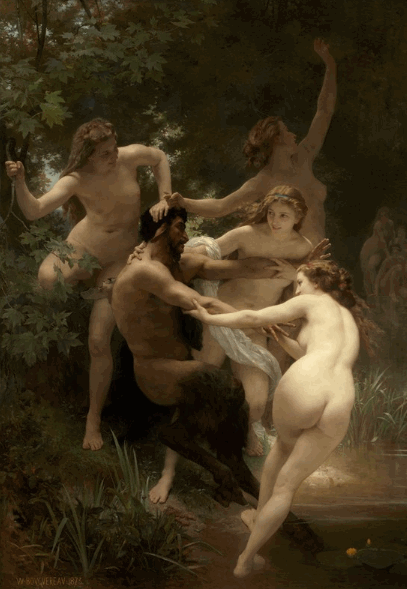
.
You don’t really need to know what nymphs are, or what satyrs are to appreciate this work. But knowing the story behind them adds a three-dimensional understanding of the art and what is being portrayed.
Nymphs are from Greek mythology. They are considered to be minor female deities, and have a duty to protect different elements of nature such as streams, mountains and meadows (pantheon). The male counterpart for a nymph is a satyr. A satyr is a creature also from Greek mythology having the torso and face of a man, ears and tail of a horse, and feet of a goat. They are known for being lustful and fertile creatures.
I can’t help but respond that Bouguereau captures an incredible sense of motion in this piece.
One can feel the struggle for the satyr to keep his ground, and the nymphs’ joyous struggle to pull him in. You can just feel the easy going, caviler attitude and peace in the pastoral scene. You can hear the water nymph’s jovial joking and feel their tugging towards the placid pond.
It’s like puppies playing. Or like kittens running around. It’s like small boys and girls playing in the yard on a nice sunny blue-sky day. It’s like Fresca and orange soda, peanut butter sandwiches and very-berry Cool-Aide. It’s water out of a green water-hose on a hot summer day, climbing trees, and riding your banana-seat, high-handle-bars bike all around town.

.
Why I love this picture is actually unknown. Somehow, and in some deep way it stirs my soul. But I really cannot vocalize what that special something is. It speaks to me in a deep visceral manner.
.
And that’s the way life is. Not everyone can appreciate how you might feel about a “thing”, or an “object”, or a “piece of art”, or a “bauble”. So you just don’t try.
Consider the Movie “The Object of Beauty“.
It’s pretty much a forgotten movie. Not well appreciated. Just something from the early 1990’s. But it makes a point about what art and beauty and appreciation is… all in terms of the early 1990’s – the decades of greed, swindles and anything / everything for a buck.
And that movie revolves around a small figurine statue. One that is worth money. But is coveted by the owners as a medium of exchange, but stolen by a housekeeper who appreciates it’s intangible beauty…
*sigh*
rare gem overlooked as much as statue nuntukamen18 December 2004 It is difficult for me to comprehend why there is only one viewer comment for this film, or why it is rated under a six. If an excellent film is about entertainment, intelligence, great acting and a terrific story with a treasury of clever humor that expounds the deeper meaning of a good relationship between a man and a woman over wealth and selfishly egotistical success, then this is a standout film that achieves a richness of artistic accomplishment that very few films do. No one truly sees the beauty of the bronze statue except the lowly and weathered housekeeper, a financially struggling mute, unable to express the profound feelings that are moving within her in words, but Rudi Davies sure gets it across with her expression and eyes. I had to drive 30 miles to the Cedar Lee Theater, Cleveland's only real art house, during it's original release, but after the film was over I realized it would have been worthwhile if I would have had to walk... ...some films are just that special.
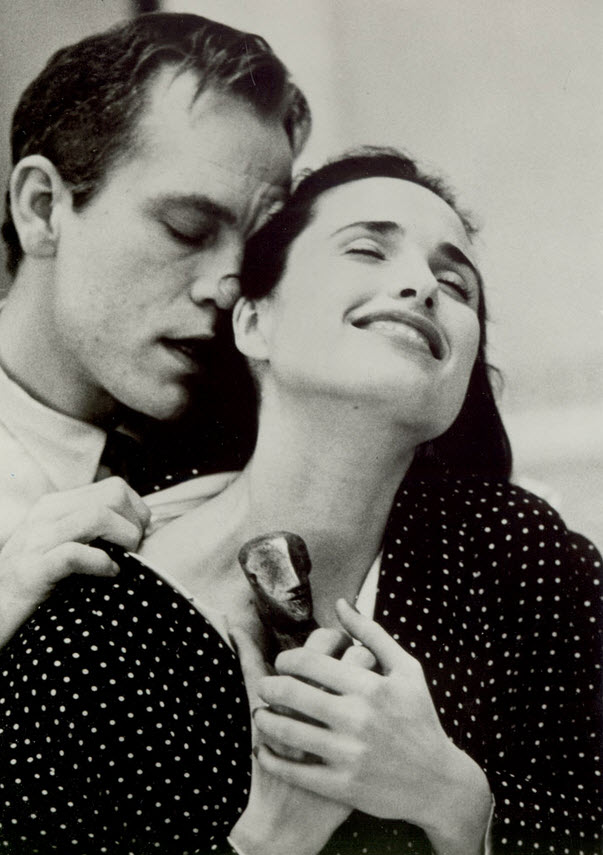
.
But back to the painting…
When I was a young boy, I actually saw this painting. It sat there predominantly on the wall facing the stairs as you walked up and into the museum proper. My parents went it, and took the right at the top of the stairs and enters. But I didn’t.
And to be very truthful, I just stood there on the steps looking up at it in amazement. It was larger than life to me and spoke to me…
…though, as a boy, I didn’t understand the language.
This work of art is spellbinding.
.
…
Art and the appreciation of it is a personal matter. And today, art is used as a medium to funnel large amounts of money back and forth between oligarchy members without concern. It’s a method of banking. Not an object of beauty, desire or of significance.
Today, ah, no one cares…
As an aside, the DA in Arkansas used my collection of books on art and artists as exhibits as to how terribly “evil” I was. I cannot remember the entire spiel that he gave to my attorney, because frankly, I was taken back at his ignorance and assault on my sensibilities. But a couple phrases stood out…
- “...a painting depicting Satan surrounded by nude women…”
- (my) “...obsession with female nudes…”
What is art and beautiful to one observer is evil and a threat to another. Do not make my mistake and think that everyone else can see beauty as you can, or who can understand things as you do, or who appreciates the world in different ways.
And when I was arrested, it was not for the possession of these works of art, or associated books. It was for two images on my laptop computer.
- A Japanese comic that had a octopus having sex with a cat-like-person.
- A photo that a doctor said was a girl under the age of 18 showing her genitals.
In Arkansas both images are considered “child pornography”. And each image had up to 40 years imprisonment. So I was facing 80 years.
Pretty fucking weird for a state that allowed people to get married to 16 year old girls. Was a “dry country” where you had to drive into Tennessee to buy alcohol. And where the Church in Down Town Little Rock was larger than the State Capital Building.
You know, I shared a cell in Arkansas at the ADC Brickey’s unit who got two years for killing a guy. I got five years for having two pictures. I just shake my head in perplexing exasperation.
But I digress.
I guess, at heart, I’m just a “hippie”, a “60’s child”.

.
Can you imagine what America would have been like if the Bozos that run America today were in charge of America back in the 1960’s?
Shudder.
GOP lawmaker: God told me to remove rape exceptions from ... https://deadstate.org/gop-lawmaker-god-told-me-to... May 24, 2019 · Hill, who is an evangelical Christian, says that the initial exceptions were only there to ensure that the bill would pass. Even though it picked up 20 co-sponsors, it died without getting a hearing in any committee. Hill told the group in Pensacola that he plans to bring the bill back as God intended it, “without any exceptions.”
The point that I want to make is that the emotions that I now feel when I look at these great works of art are now polluted with the imagery of my memories when I dealt with the military police in Arkansas. And while my story seems to be unique, all of the rest of my MAJestic cell had similar stories. And yes, others now call me a real sick person for having those images on my computer. I get it. I understand.
And now, I live a life where I cannot enjoy art like I used to.
I’ll never forget the phrase “you can paint houses“.
And this gem; “no one wants to see paintings like this when all you need do is take a picture“.
And of course the standard narrative; “people like you need to be locked up and separated from society until your malfunction can be corrected“.
We must realize and recognize that there are others, often sick people, who are in positions of power and control and who can squash your life out like an insect. Sick people. Evil people. In positions of power.

.
Takes away from the beauty of that great painting, eh?
Yes.
That’s my point.
Pat Robertson says God told him Trump ‘is going to win ... https://www.christianpost.com/news/pat-robertson... Oct 21, 2020 · Christian Broadcasting Network chairman and televangelist Pat Robertson said Monday that he believes God told him President Donald Trump will be re-elected for a second term but great civil unrest will ensue. “I want to say without question, Trump is going to win the election,” Robertson said on “The 700 Club” Tuesday. “… The election that’s coming up in just a few weeks at which time, according to what I believe the Lord told …
Art is all about the emotions you have while looking at the artwork
I enjoy art because of the feelings and the thoughts and memories they generate.
But, you know…
Some people cannot emote.
They cannot feel emotions. They cannot “relate” to others they are unable to emote or understand how others feel. To them, they cannot see art as anything other than a “thing”, a commodity that you can trick others into buying. These people with this mental illness occupy a significant percentage of our society. Some say that it is even as high as 10%. But one thing is for certain, the ability to make money and accumulate fortunes are in the strong suit for these people.
Thus, in a nation that values money above all else, where capitalism reins supreme you will find these people in positions of power and control.

.
The American leadership; the American Oligarchy are are… are… unable to emote. They are unable to experience emotions or understand the emotions of others.
Why?
What are these people’s problem?
Perhaps this video might provide some insight to how the rest of the world views America at this point in time. A point in time, mind you, where the government does not care about the citizens. It only cares of about keeping them down, subservient, and compliant, while they run amok in their crazy delusions and obscene objectives.
Uh…
And one more thing, you will never see this kind of information on any of the Alt-Right, Alt-Left or Mainstream American media. They would rather die than face the truth.
…
Keep that thought in mind. A thought that says that the craziest and most evil people thrive within the American capitalist “democracy” as it exists today. And the most evil, the most selfish, and the most manipulative are able to rise to extreme levels of power and control within the American environment.
Ah.
It’s upsetting.
But let’s move one and look at some more Art. Let’s consider the fact that unlike the products that are churned out of America today, these works endure. They persist and they are established as a stable foundation for what the human species represents. Let’s look at some more of the great works by William Adolphe Bouguereau.
La Vierge aux Anges
Here we have a trio of angels playing music for baby Jesus and the Virgin Mother Mary. I love this picture, and it evokes in me the feelings of love caring, compassion and peace.
This painting can be seen elsewhere on the internet. It is embraced by religious websites and in the websites devoted to greeting and gift cards. I have even seen (I believe) this work reproduced on pictures, post cards, and such things as plates and clocks. A simple image search on Google will help you all find the great diversity of the for-profit avenues that people have used with this work.
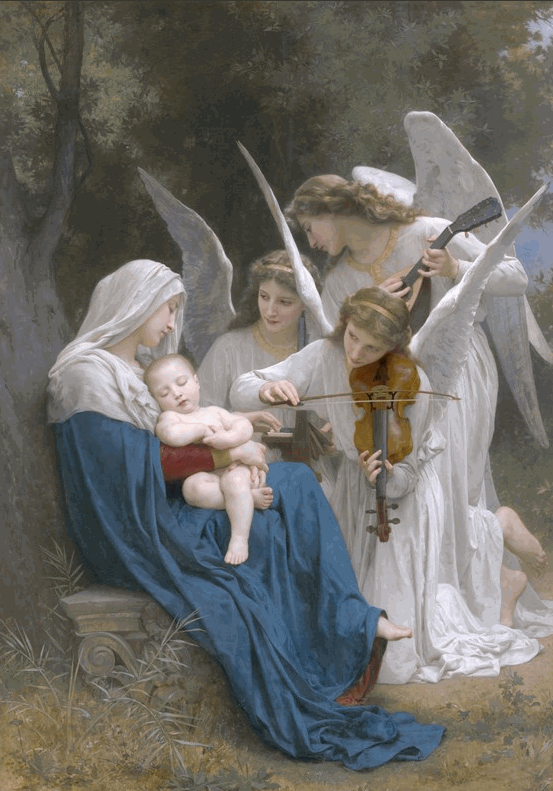
.
Usually, Mary is depicted in blue and white, which I haven’t a clue as to why. And the angels tend to be in shades of white, which is also something that I have no idea about either. Never the less, this is a beautiful painting and very calming.
The Virgin with Angels is a 1900 painting by William-Adolphe Bouguereau. The painting media is oil on canvas, and it measures 185 × 285 cm (72.8 × 112.2 in). It’s a large painting at 6 feet by 9 feet. I imagine that when he painted this, he intended to show the love of the Mother Mary with the baby Jesus and the beauty and support of the surrounding angels. I cannot imagine what he would think that this image was being used on plates and cheap products at Walmart to support a for-profit motive.
When my home was raided they said nothing about this picture. Except maybe a quick pause before they turned the page. It’s hard to find something fundamentally wrong with angels playing violins and other musical instruments. So they just glossed over this painting and went on to the next one..
It’s lovely. Don’t you agree?
Petites Maraudeuses
But they did stop at this painting in the book.
This is a typical work of his. His works that depict children and the life of play are great themes and I well remember some homes of both uncles and aunties that had these kinds of works in their living rooms. (Of course, with a “Great Supper” painting in the kitchen or dining room.)
It is so calming…
It is titled “Little Thieves”. And while the detective and the police didn’t stop to read the captions or text inside the coffee table book, they used the artwork to grill me and goad me to admit to something ignorant and evil.
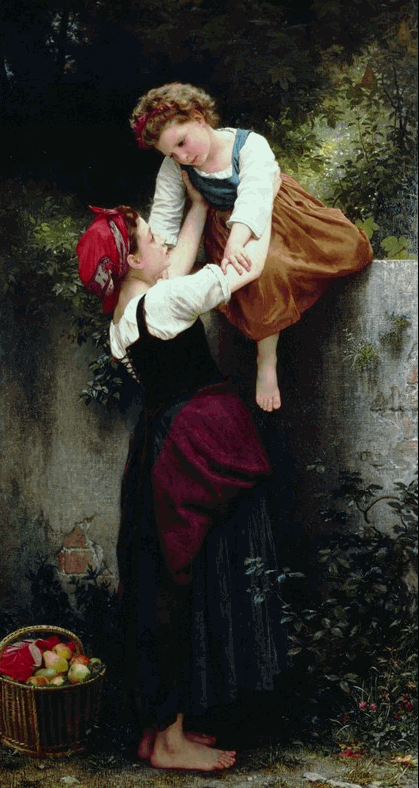
.
I once worked with a fellow engineer in Boston. He was a plastics engineer from Pakistan. He saw that I had a miniature reproduction (of this painting) in my office and fell in love with the painting. He used to come into my office and we would chat. But he would always look up at the painting with this kind of far-away look in his eyes. It meant something to him. But his pride was such that he would never admit to it.
So I gave it to him when I was sacked by the company (Laid Off). When I gave it to him he was surprised and he wondered why I did so, and that yes (of course) he would accept it. He said that he secretly loved the painting. He said that it reminded him of his boyhood home. In Pakistan.
Lovely.
The techniques of Bouguereau
You have to admit that this artist had mastered his technique. Is there anything for us to learn?
From the Art Renewal Center…
To fully appreciate the art of Bouguereau one must profess a deep respect for the discipline of drawing and the craft of traditional picture-making; one must likewise submit to the mystery of illusion as one of painting's most characteristic and sublime powers. Bouguereau's vast repertory of playful and poetic images cannot help but appeal to those who are fascinated with nature's appearances and with the celebration of human sentiment frankly and unabashedly expressed. But it remains to understand, given Bouguereau's in many ways unique style, exactly what the artist was trying to represent. Although Bouguereau has been classified by many writers as a Realist painter, because of the apparent photographic nature of his illusions, the painter otherwise has little in common with other artists belonging to the Realist movement. Bouguereau himself regarded his tastes as eclectic, and his work indeed exhibits characteristics peculiar to Neo-Classicism, Romanticism, and Impressionism, as well as to Realism. Within these categories, the painter is perhaps best understood as a Romantic Realist, but one would also be quite justified in this case in devising an entirely new school of painting and labeling him the first, the quintessential Photo-Idealist. The designation is apt in that, although Bouguereau actively collected photographs and tempered his observations of nature with a keen awareness of the qualities of light inherent in the photographic image, he almost never worked from photographs.1 The rare exceptions are a few portraits, usually of posthumous subjects, which are readily identifiable as photographic derivatives as they exhibit an uncharacteristic flatness and pose. Bouguereau and his fellow academicians practiced a method of painting that had been developed and refined over the centuries in order to bring to vivid life imagined scenes from history, literature, and fantasy. The process of acquisition of the skills necessary to produce a first-rate academic painting was a long and laborious one. ... The idealizations of Bouguereau's imaginary universe, which have delighted some critics, have incurred the wrath of others. Although some of the latter have loudly lamented the over-romanticized image of the French peasant presented by the painter, few of them have bothered to contemplate the heroic attention required to sustain such a vision of perfection in a less than perfect age. Moreover, as Bouguereau's contemporary Emile Bayard observed: It is good to note, in any case, that dirt and rags are not exclusive to the underprivileged and that indigence is not always clothed the same way. 4 A similar charge often leveled at Bouguereau is that his art bears little or no relationship to the realities of political, industrial, and urban life in nineteenth-century France. But if Bouguereau's art ignores in its content the pressing issues of the day, it may very well be because the artist, though well aware of them, nevertheless prompts us to lift our eyes from the ground and focus upon the lures of distant Arcadia; when misery is afoot, to exalt the more pleasant possibilities of la vie champetre is not artistic falsehood. If one pronounces Bouguereau to have been out of step with his time, what must one then conclude about the many, many critics and collectors and viewers who supported him and others of a similar artistic persuasion? Could he really have achieved such prominence and financial success by going against the grain of the "realities" of the nineteenth century? Exactly what are those realities and exactly what attitude was a visual artist obligated to take toward them? If the accomplishments of Bouguereau are poorly understood today, that may have something to do with the shifting of aesthetic expectations over time. As for Bouguereau's public, it was a public raised on Raphael , a public that had not yet been conditioned to prefer abstract ideas to the palpable images that give them utterance, a public that insisted upon an obvious narrative content and that saw in Bouguereau someone opposed to the trends it regarded as inimical to art. It may very well be that a determining factor in Bouguereau's success as a painter, apart from his talent, was that he allied himself to that sizeable, conservative, and revisionist element of French Roman Catholicism which, under the aegis of such men as Louis Veuillot , popular theologian and publisher of L'Univers, refused to yield to the attacks on traditional ideals that were current at the time.
The craft of picture-making as practiced by Bouguereau basically followed the principles of academic theory as codified by the seventeenth-century aesthetician Roger de Piles.
The code embodied the fundamental idea whereby a painting could be judged logically and objectively by its conformity to ideals established for its divisible parts, which were determined to be: composition, drawing, color harmony, and expression.
The method Bouguereau used to execute his important paintings provided ample opportunity for the study and resolution of problems that might arise in each of these areas.
The separate steps leading to the genesis of a painting were:
- Croquis and tracings
- Oil sketch and/or grisaille study
- Highly finished drawings for all the figures in the composition, as well as drapery studies and foliage studies
- Detailed studies in oil for heads, hands, animals, etc.
- Cartoon; and, only then
- the finished painting.
Evidently Bouguereau was constantly making croquis or “thumb nail sketches.” Often these preliminary studies were done during meetings at the Institut or in the evenings after supper.
For the most part they were scribbled from the artist’s memory or imagination, others were sketched directly from nature.
These drawings, hitherto unknown to the public, constitute a very important element of Bouguereau’s work. For one thing, they yield a wealth of information about the artist’s method.
They also show in many cases how a particular composition evolved. Executed either in pencil or ink, they served as a means of determining the grandes lignes, the important linear flows and arabesques, within the entire composition and within individual figure groups as well. They were often refined by means of successive tracings.
The oil sketches, grisailles, and compositional studies in vine charcoal served as means for determining appropriate color harmonies and for the “spotting” of lights and darks.
Like the croquis, these were usually executed from imagination and yielded a fairly abstract pattern of colors and greys upon which the artist would later superimpose his observations from nature.
The figure drawings represented the first important contact with nature in the evolution of the work. Among the considerations of the artist at this point were anatomy, pose, foreshortening, perspective, proportion and, to some degree, modeling. Although Bouguereau was reputed to have the best models in Paris, some of them were not always the most cooperative; as one observer noted:
Bouguereau's Italian model-women are instructed to bring their infant offspring, their tiny sisters and brothers, and the progeny of their highly prolific quarter. Once in the studio, the little human frogs are undressed and allowed to roll around on the floor, to play, to quarrel, and to wail in lamentation. They dirty up the room a great deal — they bring in a great deal of dirt that they do not make. They are neither savory nor aristocratic nor angelic, these brats from the embryo-land of Virgil. But out of them the artist makes his capital. Sketchbook in hand, he records their movements as they tumble on the floor; he draws the curves and turns of their aldermanic bodies, and he counts the creases of fat on their plump thighs as Audobon counted the scales on the legs of his humming-birds. 7
At times Bouguereau was obliged to use sculptural sources. J. Carroll Beckwith wrote:
Entering Bouguereau's studio one morning, before he had come up from his breakfast, I was studying with interest a large canvas half completed, representing a group of laughing children with a donkey [see cat. no. 72]. A gaudily attired Italian woman was endeavoring to pacify a curly-headed cherub, the model for the morning, who was ruthlessly rubbing his dirty fingers over some exquisite pencil drawings which lay on the floor at the foot of the easel. I rescued the drawings, while the mother apologetically explained to me in Neapolitan French that M. Bouguereau spoiled all of her children so that she could do nothing with them at home or elsewhere. The drawings were beautiful reproductions of the Laughing Faun in the sculpture gallery of the Louvre. As Bouguereau entered the room, he began a series of frolics with the youngster which quite verified the words of the mother. [When be stopped] at last to set his palette, I asked him when he had made the drawings. "Oh, you see, that mauvais sujet is so wicked", said he, pointing to the curly-headed urchin turning somersaults on the floor, "that I can use him for nothing but color and was obliged to spend nearly all of yesterday afternoon at the Louvre, making these notes for the form. 8
If a particular figure was to be clothed, Bouguereau would also make drapery studies by posing a mannequin in place of the model and experimenting with the folds of cloth until a disposition was found that enhanced the underlying forms.
Sometimes, especially for small or single-figure paintings, Bouguereau drew the model already draped.
Most of the figure drawings were executed in pencil or charcoal (or a combination of the two) and were often heightened with white. The support for them is usually a heavyweight toned paper of medium grain; such a background allowed Bouguereau to dispense with the problem of rendering troublesome halftones which, in any event, were more easily and accurately realized in the painted studies.
To read more about his techniques, please go HERE. It goes into great detail and goes into the various mixes he used. Great stuff for certain.
Can you imagine trying to do this today? Man oh man, you’d be locked up for-ever.
Alma Parens L’âme parentale
Wow. Oh wow. This is an allegorical painting with a ton-load of meaning. It means “The Motherland”.
Of course, the folk in Arkansas found this work “disgusting“, “abhorrent to normal sensibilities” and further evidence of my “sick nature” and “outrageously dangerous desires”.
Sigh.
And yeah, I get it.
You all don’t want to hear what the nit-wits think in Arkansas. But you are gonna hear about it here. You can leave if you don’t like to face reality. The last four years in Washington was populated with these exact kind of people. And no, I am not going to “let by-gones be by-gones”…
It’s a uni-party. There are no Republicans nor Democrats. There is just the 10% of psychopaths that run the nation, and the rest of us being treated like cattle in the process.
Is this too “salty” for ya?
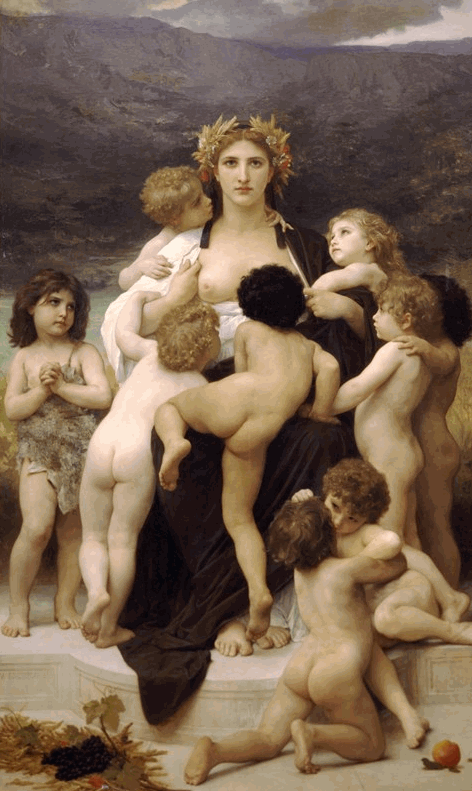
.
I know that I am supposed to accept the fact that anything even remotely suggestive of children or sex is a threat to my very existence as I am now branded with the scarlet letter of being a “Sex Offender”. And I know that somehow, having those two images on my computer; the cartoon and the photo of the chick without clothes on created “victims”. I cannot reconcile how the image of a mother tending to her brood is in any way representative of the horrors so massively promoted in American media. You have to be a moron to connect the two…
…but, you know, have you looked at America today?
Know who you are dealing with, and recognize that these people still are in various positions in government today. Look at this jackass. Look at this pencil neck.

.
Hey, check out the kinds of bills that he was working on in 2020. Keep in mind this one very important point. Which of his sponsored bills actually helps and supports normal, working people inside his district in Arkansas. Yeah. go over the list.
Which ones?
Go over the list. Where during 2020 has he sponsored any legislation to help his citizens aside from the emergency related to Coronavirus? Instead it seems like he’s got a real problem with sex, China, and making sure that the Untied States government is protected against the citizenry.
- Colors in RED are all about China. Yeah, he most certainly has a real “hard on” about China.
- Colors in Blue are all about sexual exploitation of children.
- Colors in PURPLE are all about making the government immune from protests and legal actions by the citizenry.
- Colors in GOLD are for dealing with the Coronavirus.
He’s typical.
Do you really think he cares about people? Do you think that he cares about families? Do you think that he cares about anything other than money and hate?
Well… apparently God disagrees with me…
Evangelical Pastor Claims God Says, 'I'm Not Happy About ... https://www.newsweek.com/evangelical-pastor-claims... Nov 05, 2020 · Evangelical Pastor Claims God Says, 'I'm Not Happy About What You're Doing to My Man' Trump in Election. By Jason Lemon On 11/5/20 at 6:49 PM EST. U.S. Evangelicals Evangelical Christians Donald ...
These people… those that take the role in government… end up becoming a tool. They end up turning into something else. Something bad. And they allow terrible things to happen, because “they are just doing their job”...
Flagellation de Notre Seigneur Jesus Christ
The Flagellation of Christ, 1880 is one of Bouguereau's masterpieces, and today hangs at the Baptistery of La Rochelle Cathedral, France. Christ, tied to a column, limply hangs, his feet dragging on the ground and head hung back, he submits to his fate. -Flagellation de Notre Seigneur Jesus Christ
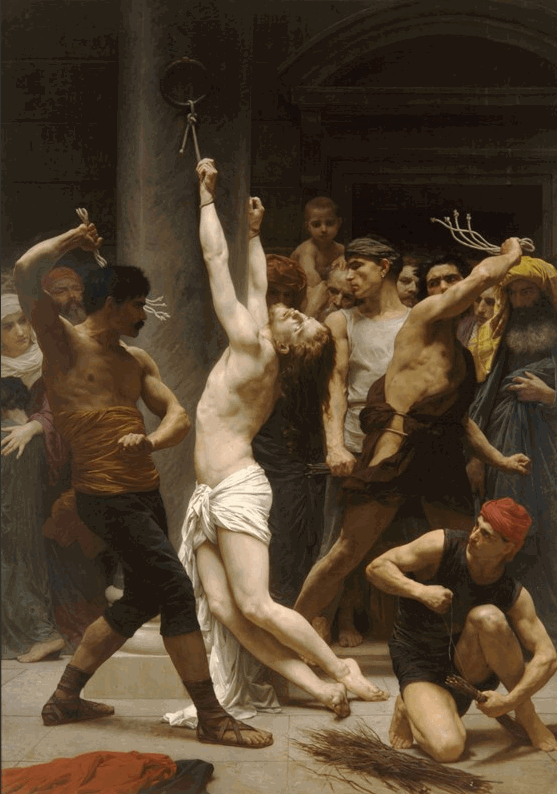
The Flagellation of Christ, 1880 is one of Bouguereau's masterpieces, and today hangs at the Baptistery of La Rochelle Cathedral, France. Christ, tied to a column, limply hangs, his feet dragging on the ground and head hung back, he submits to his fate. Two men stand in mid swing with their whipping ropes, with a third kneeling to the lower right fastening birch branches for the next stage of the torture. Unlike the two men who are whipping or the forth man standing behind with birch branches in the ready, the kneeling man tying the branches appears to show some remorse for his actions as his hand muscles loosen slightly with the pull of the string. The viewer can feel the pain of Christ's torment, though his eyes are vacant of expression as if his soul is in another place. The crowd surrounding this event is filled with curious spectators. To the left, a young boy shelters his eyes from the horrid sight by turning his back and pressing himself against his mother. To the right, just above Christ's head, a baby looks down at him sympathetically while hoisted up on his father's shoulders. Through the crowd, a bearded man looks directly at the viewer, thereby pulling the audience into the scene as if they are too part of the crowd. It is possible that this bearded man with furrowed brow is a self portrait, so both Bouguereau and the viewer are witnessing this scene. This life size capa d'opera is every bit as magnificent as any religious works done by Raphael, Caravaggio, or Velasquez. The harmonious interplay of drawing, paint handling, composition, perspective and emotional thrust are second to none in their expressive power. -by Kara Lysandra Ross Excerpt from the article: William Bouguereau and his Religious Works
And you know, the detective in charge of the entire raid and my case had some very piercing things to say about this work of art. And I have never forgotten her words…
“…this preoccupation with torture, young children, and nudes point to a serious mental illness that needs to be eradicated from our treasured citizenry…”
Yeah.
So you want to know what it was like for me being arrested and “investigated” in Arkansas…? Look at who the fuck is running that place, controlling the minds of the people there, and who are accumulating riches beyond compare. Look at them. For they ARE America.

Televangelist Pat Robertson says God told him Trump will ... https://www.dailymail.co.uk/news/article-8862797 Oct 21, 2020 · A televangelist has claimed that God told him President Donald Trump will win the upcoming election but that five years later an asteroid will hit …
Yah!
Beware of asteroids you all.
It’s all coo-coo!
When I joined MAJestic, I was instructed that I would be in it for life, but that I was forbidden to have children during my active engagements. I agreed, not realizing what that meant. I was also told that I would be alone, with no support and that I would not ever be rich or famous as that was a danger to the organization.
Maybe I was stupid for taking on this role? But I gave up so very much for this, and then to have myself retired like I was, and then have these jokers prance around in Washington DC like they do really upsets me.
I think that this exposure to what the American government is has taught me quite a bit as to what America has become; what it is, and where it is going. Unlike most Americans who read about this, or who read about that. I’ve experienced it first hand. Up front and viscerally. Don’t get all that caught up on what the media promotes. It’s all lies. Pay attending to the first-hand reports by others who’s veracity you can trust.
Cut out the bullshit.

.
Anyways, art, like music is really meaningful to me. I remember an old black and white movies from the 1940s or 1950s where there is this guy in prison who paints. It’s his only love. It’s his only hobby. Then one day the warden visits him and see that the painter painted the warden. Not good. Not bad. But realistic. But the warden responded by taking away his ability to paint. And thus destroyed his only and sole source of happiness…
This theme was repeated in the movie “One flew over the Cuckoos nest”. Where as soon as one of the inmates showed any inkling or ability to resist the shackles that were around his legs, the powers that be made sure to destroy him beyond repair.
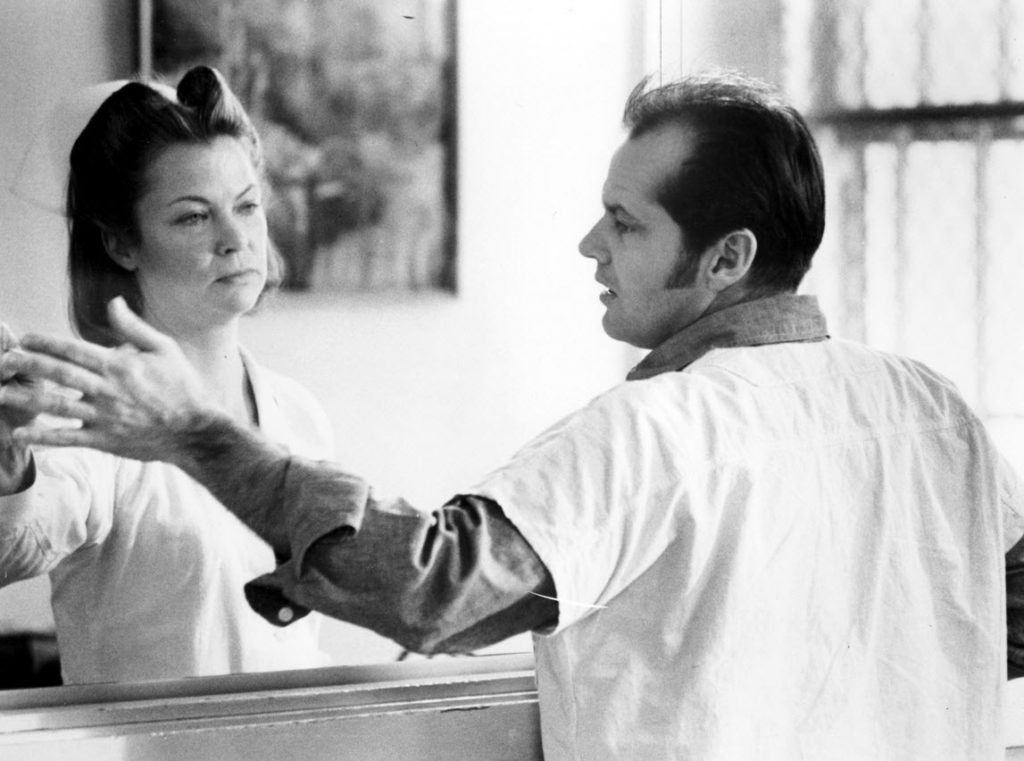
.
Le Repos
In the ADC in Arkansas we were not permitted to have any fruit. None. And one inmate who was in there for a long, long time told me that he missed bananas. He said that he could picture them. He could smell them. He could remember peeling them. But that he hadn’t held or tasted a banana in over twenty years…
… yet when I look at these paintings I see a window to a time that is long gone. A quieter time, a more peaceful time, and a time where you could only commit a crime if there was a victim. There was no such things as a victimless crime, and that the fifth amendment guaranteed that I could confront my accuser in court. Not have that entire fail-safe ignored by a plea bargain.
These paintings and this art carries me away…
I just love these relaxed paintings. Maybe this kind of life will return back to America. What do you think?
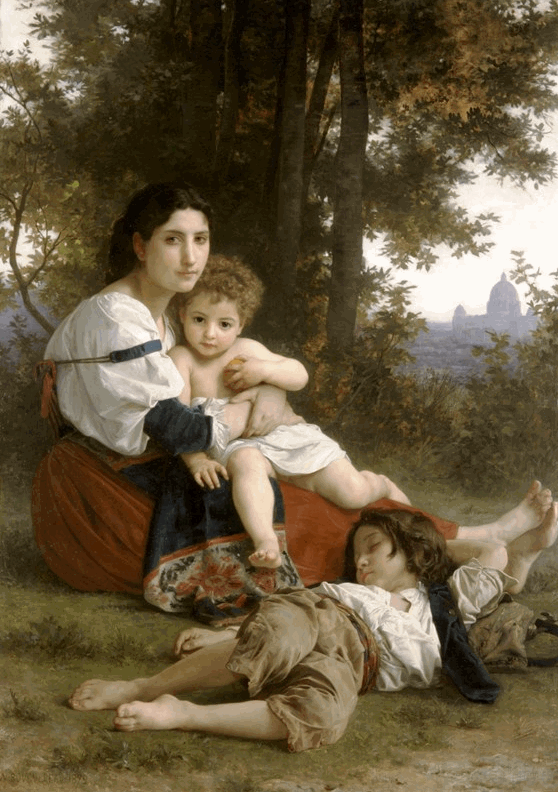
.
This image represents my ideal.
Looking at the boys’ trousers makes me want to buy a new set of oils and brushes. I really want to paint those folds and shaded legs.
La Charité
Another lovely painting.
And yes. Yet another example of how “evil and disgusting” that I am for even suggesting that it is beautiful.
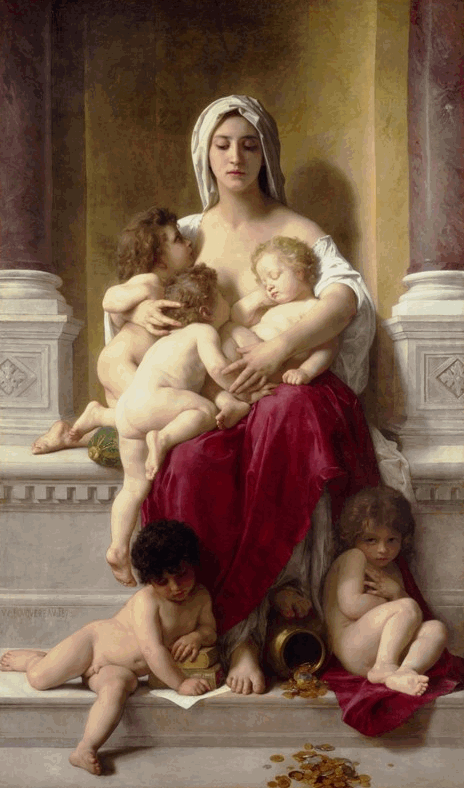
.
Yes, you know these people “talk with God” personally. And they know what evil is, and that they are the representation of what is good in the world and that which must be destroyed.
Don’t you know.
Look at this great representation of “good”…
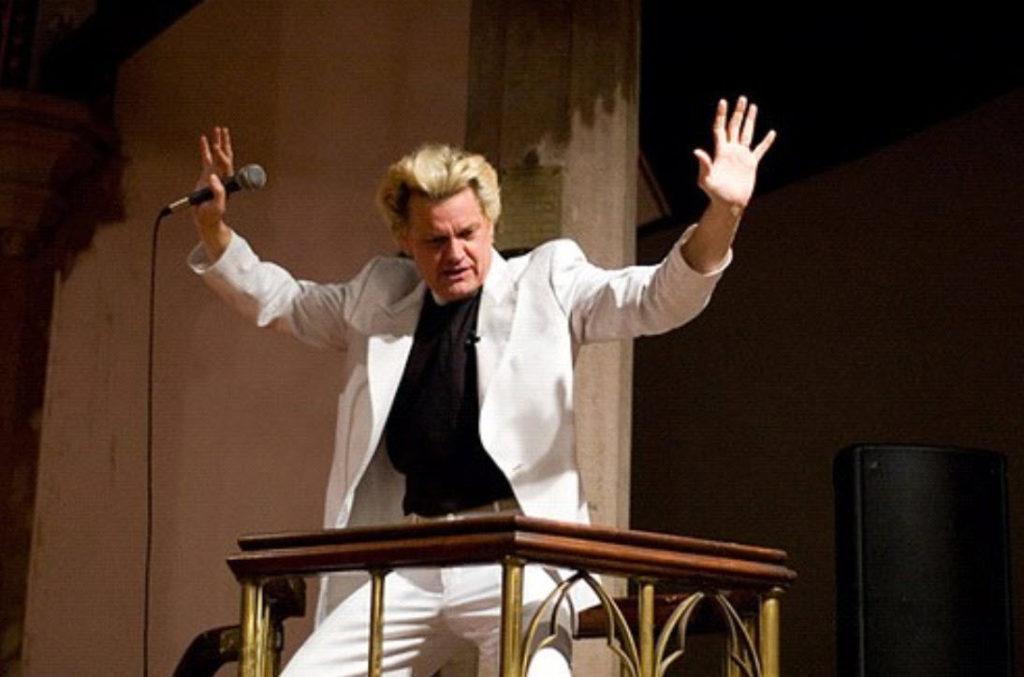
Trump Will Start the End of the World, Claim Evangelicals ... https://www.newsweek.com/trump-will-bring-about... "For his evangelical supporters, there's a sense that Trump's unlikely election to the presidency proves that he has been chosen by God," Young told Newsweek. "He shouldn't have won the election ...
Entre la richesse et l’amour
This is an age-old issue. When a young lass can choose the life before her. While it is shown as extremes in age and wealth, the story persists. How can a woman in her blossoming years decide her future life? the translation of this painting is “Between wealth and Love”. And it speaks volumes. Don’t you think?
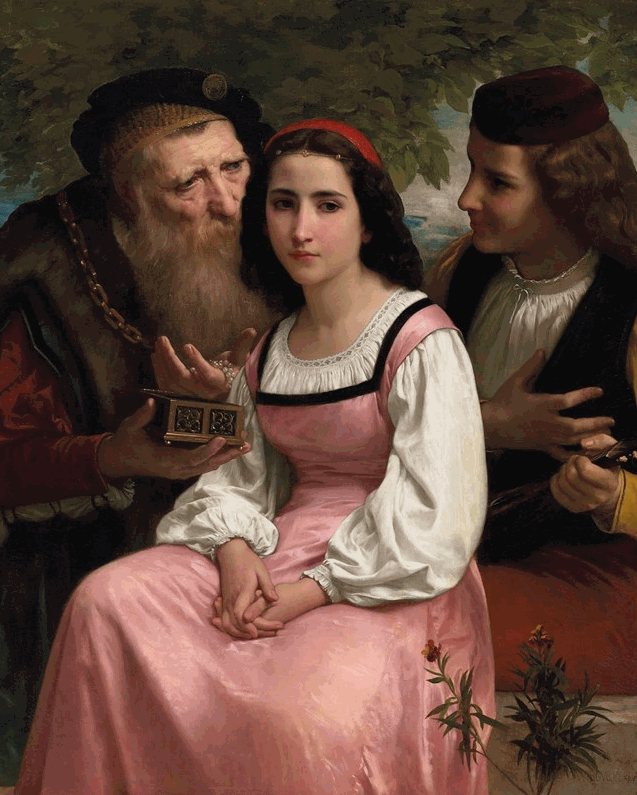
.
My favorite part of this painting is the young lass’s hands. That’s just pure art.
Le Saintes Femmes au Tombeau
Le Saintes Femmes au Tombeau, 1890, translated to The Holy Women at the Tomb, depicts the three Marys, Mary the Mother of James, Mary Magdalene and Mary of Cleophas, at the tomb of the resurrection. The viewer, compositionally, is placed in a prostrated position and looking up first notices the expressions of bewilderment on the central Mary's face before looking past the three women and into the tomb. -Le Saintes Femmes au Tombeau
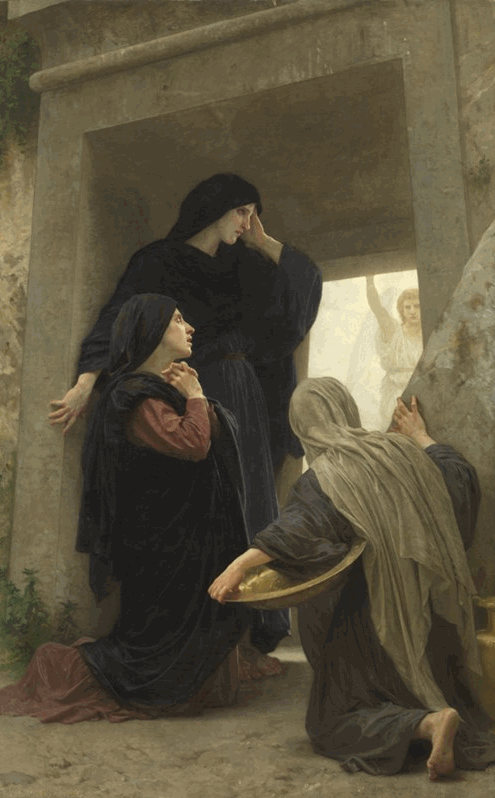
Compassion!
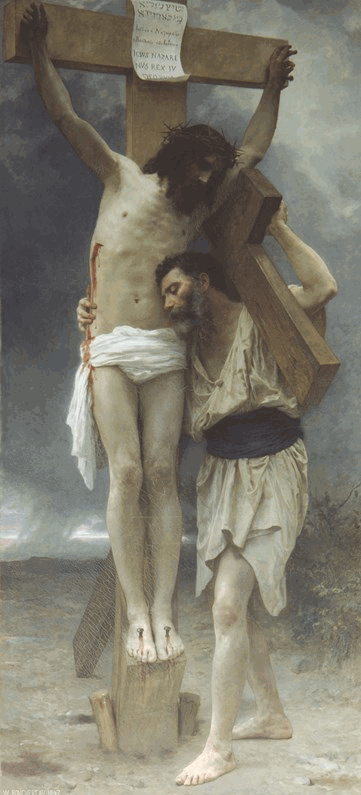
Donated by Bouguereau's descendents to the Musée D'Orsay, Paris, France, 2009 When one looks at The Compassion, 1897, at first glance the viewer may interpret this painting be simply a depiction of Christ on the Cross, with perhaps another saint, or victim. A depiction not too different from thousands of other paintings of the subject; but in fact, the subject of this painting is not simply the event, but the conversion to Christianity through the compassion for the sacrifice Jesus made. The man with his head on Jesus' chest is a representation of every man and mankind as a whole. The man in the painting shows the same empathy and bearing his own symbolic cross, has found his way to Jesus and his own redemption. Many Christians wear crosses around their necks to represent the same conviction, that they too have been sacrificed with Christ. In the bible, when Jesus fell on his way to Calvary, a man from the crowd, Simon of Cyrene, went to Jesus and carried the cross for him, which was the inspiration for this widely accepted symbol. The blood of Christ falls onto his hands, reiterating the blood sacrifice that was made for his benefit. On top of the cross a letter is posted which reads "Jesus of Nazareth, King of the Jews" in three languages, Greek, Latin, and Aramaic. Although in many depictions, Christ is crucified at the top of a mountain, Bouguereau chooses to depict the savior on a barren wasteland, symbolic of the man"s spiritual life before finding his way to Christ. Bouguereau chose to keep this painting, which shows the importance his religion played in his own life, and it remained in his studio until its recent donation to the Musèe D'Orsay, Paris, France. -by Kara Lysandra Ross Excerpt from the article: William Bouguereau and his Religious Works
Berceuse
The painting, “Berceuse” is a delightful example of Bouguereau’s more domestic works. It shows a mother sitting in a rural landscape rocking her baby’s cradle as she works at spinning thread.
The title of the painting, “Berceuse” suggests that she is also singing a lullaby to her sleeping child at whom her calm, loving gaze is directed. The composition is strongly reminiscent of a Madonna and Child and the painting as a whole is beautifully executed.
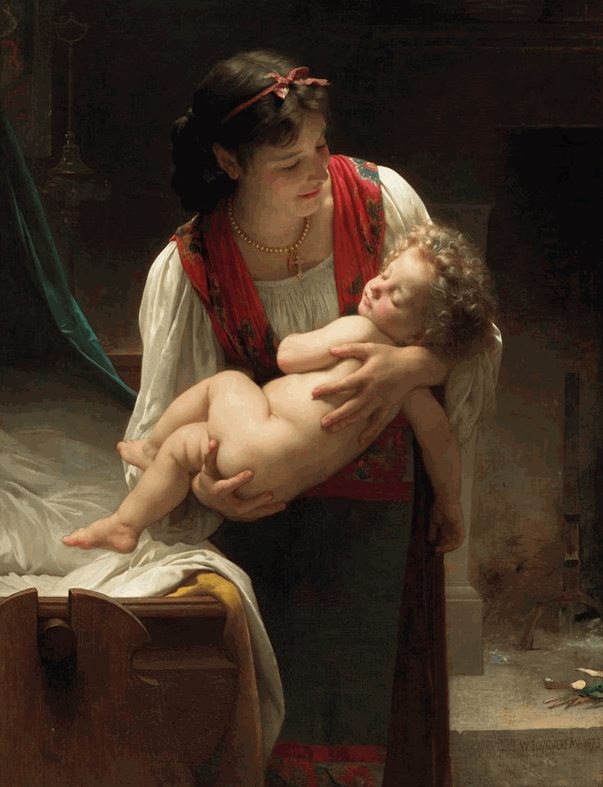
.
We can see from this painting that Bouguereau was a master of traditional academic painting and why he had wide appeal, in France and abroad, during his lifetime.
His approach to art, was however, heavily criticized by the rising impressionist painters, many of whom found much of their work rejected by the Salon. Instead they embraced more modern types and works of art. And we all know where that ended up…
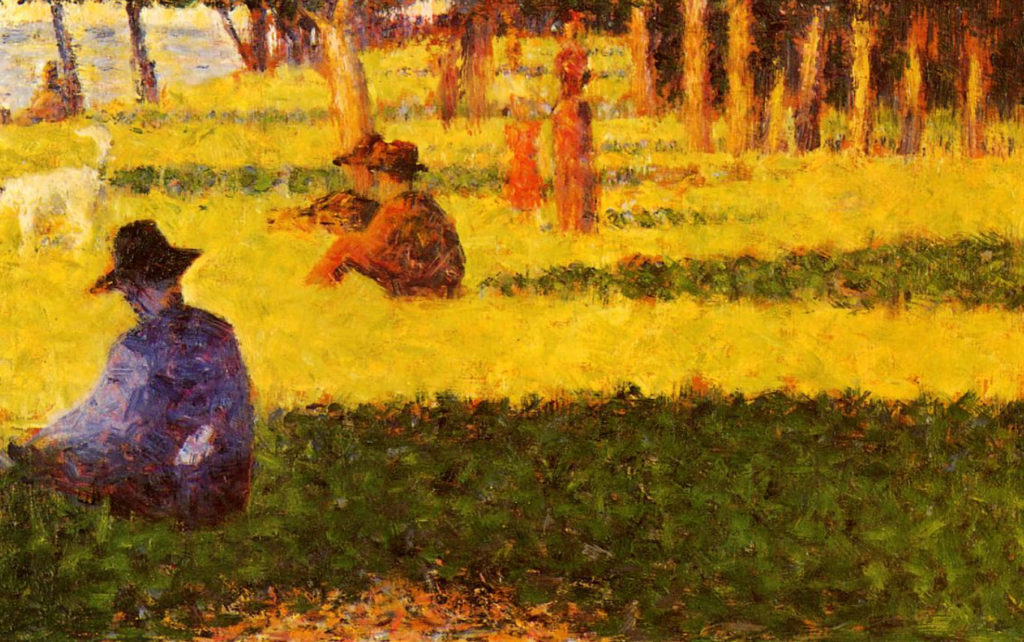
.
After his death his reputation fell steeply and his paintings were no longer admired but were seen as vacuous or overly sentimental. It is only in recent decades that his work has begun to be re-evaluated and his paintings, such as “Berceuse” appreciated once more for the skill, artistry and dedication that Bourguereau brought to his work.
The Proposal
What kind of proposal is it? Marriage?
Hardly.
Some kind of plan being hatched… curious. Very curious.
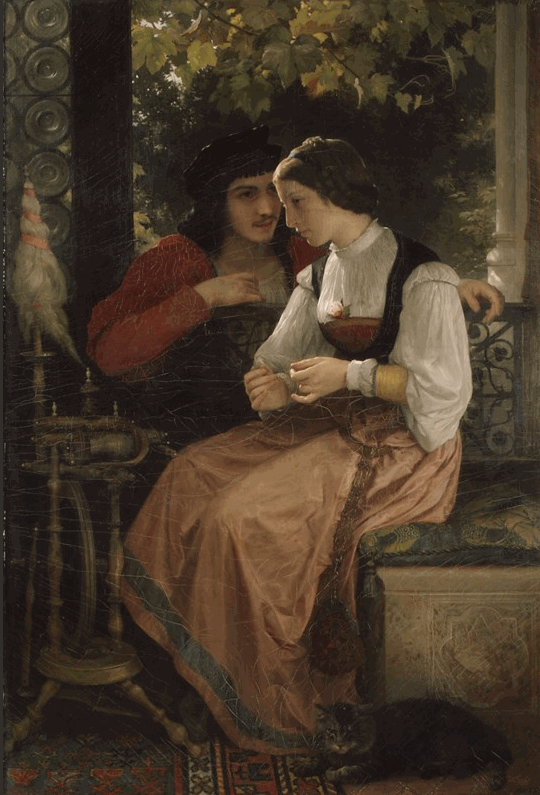
The motif of a young man at a window, wooing a woman at her spinning wheel, and the vaguely sixteenth-century German costumes and setting, led writers to associate this painting with the tragic story of Faust and Marguerite.
Johann Georg Faust was said to be an alchemist, astrologer, and magician who lived during the Renaissance period in Germany. He was an aging scholar, but at the end of his life, he fell out of love with his previously devoted scholastic endeavors in the accumulation of human knowledge. He is said to have made a contract with the devil, selling his soul to enjoy and partake in reckless earthly pleasures. The one who lured Faust away from his scholarly endeavors was said to be Méphistophélès, a malevolent devil. The story of Faust has served as inspiration for numerous literary, artistic, cinematographic and musical works throughout the ages. Even the mere term ‘Faust’ has been used to refer to ambitious people who are willing to exchange moral values for strength and success in certain fields. La Damnation de Faust – Tragic destiny ‘La Damnation de Faust’ is often interpreted to describe a tragic destiny resulting from a false wish, a trope that still holds relevance in contemporary society. In the classic play, Faust is presented as an aging scholar in desperation. He has spent his whole life in search of wisdom just to find that at the end of it all, he has gained nothing. Youth, happiness, and achievement have all slipped away from him. Even the search for wisdom can no longer inspire him. To set him free from sorrow and depression, he decides to seek death. In a singular moment, the resounding sound of a church bell and hymn remind him of his youth, of the time when he still held faith in religion. But that fleeting moment does not last long before the appearance of Méphistophélès, a malevolent devil, is seen before him. Faust, desperate and depressed almost at the point of suicide, accepts the devil’s offer of returning to him his youth, knowledge, and the fulfillment of all of his deepest desires. In return, he must, however, follow the devil and fall under his command. Seemingly, the vague and fleeting religious memory Faust experienced moments before the appearance of the devil was not enough to revive in him a strong faith in religion, in a God that he once had.| Naturally, Faust now has all that he was craving, yet, there was no way for him to know where the journey ahead would lead him. After Méphistophélès fulfills his side of the bargain he encourages Faust to seduce Marguerite, an innocent girl whom Faust had an unrequited love for, and then abandon her, alone and pregnant.
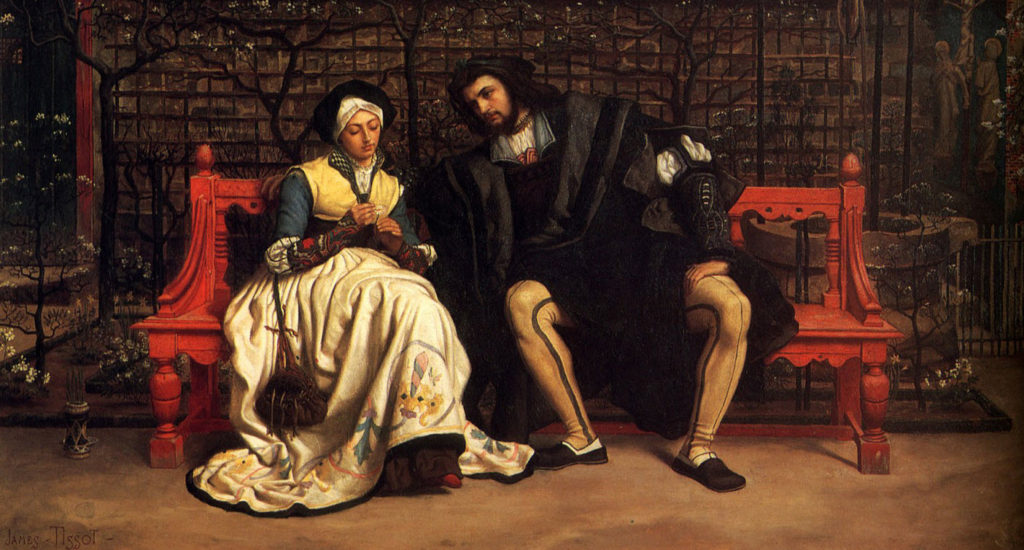
Her life falls into ruin and, so, in an effort to save his lover, Faust agrees to relinquish his soul to devil Méphistophélès. With this decision, he gives the devil every reason and ability to drag him to hell. Which he does, tragically and immediately. Perhaps his final destiny was predetermined from the very moment he accepted the offer of the devil Méphistophélès. It is a tale that resembles the story of Adam and Eve in the Garden of Eden. The devil Méphistophélès plays a role not dissimilar to the role of the serpent that tempted Eve to take a bite of the apple. Once Adam and Eve succumbed to the serpent to eat the forbidden fruit, it was determined that they would be expelled from the Garden of Eden. In the case of Faust, he yields to lust and worldly desires and culminates in hell. It is the inevitable fate for the one that chooses to go against good and side with evil. The story of Faust: An awakening bell In the contemporary era of the robust development of science and technology, in most cases, science and knowledge play a positive role in society, but at times, it can assume a negative role, as well. Especially when the scholars and scientists ignore moral and humanistic values, and put their fame and interest on top, they would disregard any adverse impact that their work might impose on humanity. Don’t we catch the image of Faust in communist philosophers, in surgeons involved in live organ harvesting from Falun Gong practitioners and in the development of nuclear warfare, to name a few? No matter what excuse they can make, the undermining effect on human society that they exert is irrefutable. In this aspect, the story of Faust can still prove its relevance to today’s society and serve as the awakening bell for those who choose to go down that path. -La Damnation de Faust
The seduction of the innocent heroine by the wicked Faust was a popular pictorial subject in the nineteenth century, inspired by Goethe’s dramatic poem and its operatic staging by Charles Gounod.
Regardless of the lovers’ identities, the lushly painted, romantic scene would have appealed to Bouguereau’s well-heeled clientele.
Admiration Maternelle – Le Bain
'M. Bouguereau is a true artist, one of the most accomplished in Paris.' -Edmond About, 1866
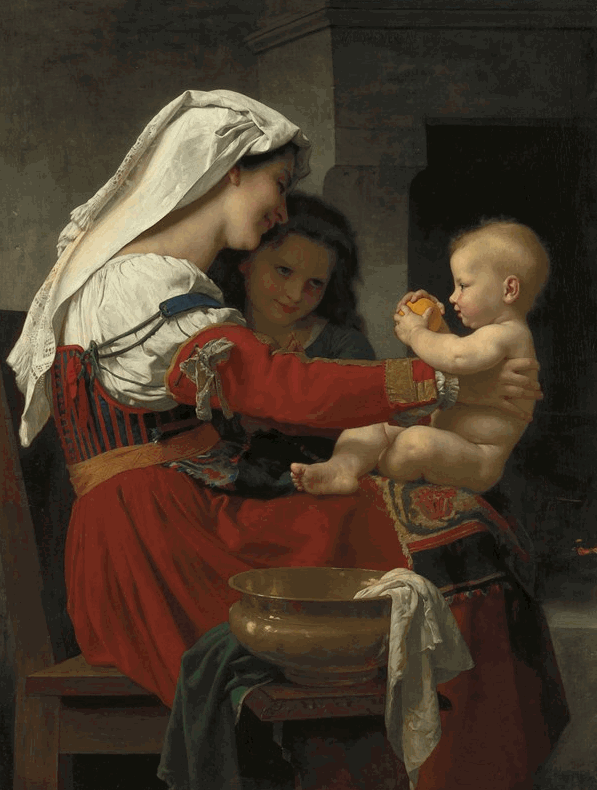
.
Beginning in 1865, Bouguereau became interested in themes of mothers and children and he began a series of paintings devoted to this subject matter. These classically-informed images were greatly influenced by his travels throughout Italy in the 1850s.
Trekking from Naples all the way to Venice over a two year period, Bouguereau was frequently confronted by religious imagery, and he was particularly impressed with the works of Raphael.

These images of mothers and children may have been further reinforced by the birth of the artist’s fourth child in 1868, a son named Adolphe Paul. It was also in this year that the artist moved his family into the house on rue Notre-Dame-des-Champs, with its large studio on the top floor of the house.
Admiration maternelle – le bain, most likely painted in the artist’s studio in 1869, depicts a young Roman mother holding her naked baby on her lap. The baby clasps an orange before him, while his older sister looks on adoringly, her hands folded together as if in prayer.
These three figures, clearly a secularized interpretation of a Holy Family or Madonna and Child with St. John, are bathed in a clear warm light which illuminates the freshly washed hair of the baby, creating a halo around his head and enhancing the association with the Christ Child.
The bowl and washcloth occupy the immediate center of the composition, bringing to mind the chalice and cloth of the Liturgy of the Eucharist. The room behind the figural group is softened by the shadows of the recesses of the interior, thereby heightening the importance of the figural group.
.
There is a photograph in the Goupil Museum in Bordeaux and in Bouguereau’s own collection of what appears to be this work (Ross and Bartoli, 1869/02) without the linen towel and basin, a different bench and a slightly different background. It is possible that the initial purchaser of the painting asked for the changes to be made, as was the case with La Bohémienne, which also had two different backgrounds. Admiration maternelle was in the collection of George Small of Baltimore by 1879, and remained in the Small family until 1984. George Small was the President of the Ashland Iron Company and a director of the Northern Central Railroad and the Baltimore and Potomac Railroad. He amassed a fortune, but he and his wife had no children, so the painting passed to his brother’s family upon his death in 1891.
Admiration Maternelle
He does capture the moment perfectly. Doesn’t he?
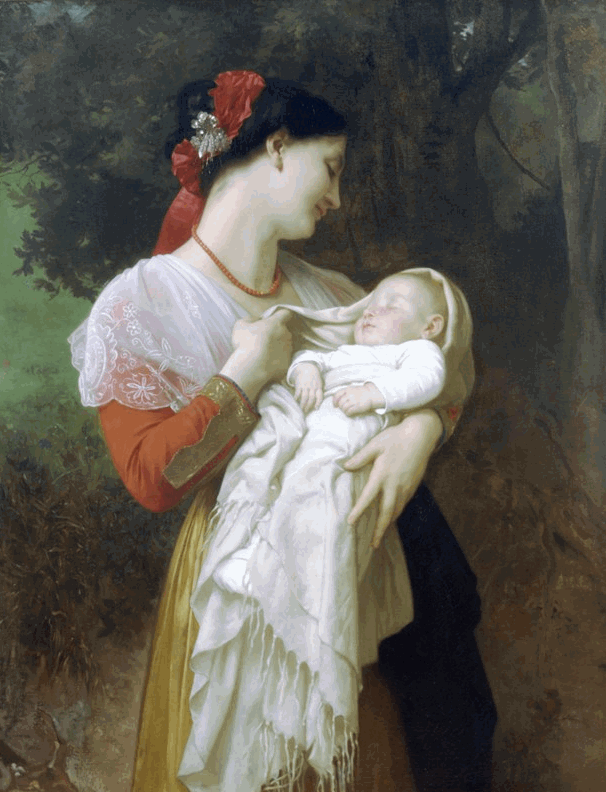
.
I love his work. I really do.
Conclusions
The artist was master of his medium and in control of his life in that time, and at that place…
In a corner of the garden measuring some two hundred square feet, he arranged his outdoor studio; and in the orangery he set up his interior studio. At six in the morning, rain or shine, drizzle or wind, escorted by his three dogs and a servant, he sets out for a two-hour walk through the fields or along the seashore. Once home, he has a cup of tea and settles down to work. At eleven, the family gathers for lunch; at one, he resumes work with his model and continues until six in the evening, with a few short breaks. Then the painter picks up his rustic cane and his soft-felt hat and leaves, a cigarette between his lips, like any ordinary bourgeois, for a walk around the harbor, to watch the sun set on the sea. When the town clocks chime seven, he goes back home for dinner; and at ten, it is curfew time. At dawn on Sundays, the master and his wife climb into a carriage to meet a childhood friend, an architect in a neighboring village, for an outing in the countryside or, during hunting season, to take a few pot shots, in his own words, "at hypothetical quails or the occasional rabbit."
When I look at these beautiful art works I still have stirrings of emotions. But that is now tainted with memories of the experiences that I had in Arkansas.
Memories that came into being by the actions of the government there; a government that employed people from both political parties… working in unison for their own self-worth and future fortunes. Greedy fucks. Ignorant of the true realities and consequences of their actions and their activities.
You take something that I enjoyed and you poison it with bad memories. It’s that the very fundamental nature of PTSD?
Memories that were and still are painful.
In fact, I often wonder if this was it’s intended purpose, by a some gleeful evil psychopaths to forever alter my love of art and to convert it and change it into something substantially different.
Into a ugly and foul thing…
Much like the premise in the movie A Clockwork Orange.
A controversial and offensive masterpiece. tyson-hunsaker31 January 2017 Anyone looking to watch A Clockwork Orange might be wanting to revisit some of Stanley Kubrik's work and might be interested in studying this film. Those who have already seen this film tend to already have strong opinions regarding this dark sci-fi movie but for me, I approached this film recently to obtain an opinion for myself and study one of the great masters of cinema. The fact that this film was regarded as one of the most controversial films ever made (rightfully so) sparked genuine curiosity to give this flick a full viewing and while I have large issues with the film, the experience as a whole was both satisfying and a learning experience. This story centers on "Alex" our main protagonist and his gang of hoodlums set in a not so distant, dystopian Great Britain. The beginning portion unfolds Alex's dark and twisted soul as we watch him and his gang fight, rape, and kill. When he's eventually caught, he undergoes controversial "treatment" to be cured of his dark soul. I first appreciated the inmate concepts of this story and the type of questions the story attempted to raise to the audience. Furthermore, much of the psychological ideologies surrounding freedom, choice, good vs evil, and selfishness were extremely thought-provoking. It had a way of making me feel self-exploratory despite the character's complete inability to relate with (hopefully) any viewer. Performances were top notch; especially from the lead: Malcom McDowell. His performance felt so authentic there's never a single moment that feels fake or forced with his dark character. As always, Stanley Kubrick directs the hell out of this. His commanding and authoritative shooting style is apparent in every frame of the picture and he does a wonderful job at sucking the viewer into this terrible world to the point of enthrallment. While all these positives make for a great movie-going experience and when Kubrick is at the director's helm not much can go wrong, the film's biggest downfall is indeed its controversy. Disturbing subject matter in this piece is indeed vital to the essence of the story but taking off the gloves when it comes to fighting, rape, and killing (especially the rape) make this so incredibly disturbing that it's difficult to muscle through. I found that A Clockwork Orange was not only offense because of its disturbing content, it was personally offensive in so many ways. Frankly, these extremely rare and offensive movie experiences are not quite the reason I enjoy films in the first place; stories can still be thought-provoking while not morally offend and damage the viewer internally. In addition, a viewer looking to study the work of Stanley Kubrick can still experience some of cinema's greatest and transcendent experiences without feeling like their conscience has blackened. It's understandable that not everyone feels this way; just as stated before, opinions about this film are all across the board. As time has passed however, A Clockwork Orange has stood out has one of Kubrick's finest and has been adored by die-hard fans so much its fan base has grown over the years. The best advice to give is to see it for yourself. Much like all other Kubrick films, relying on anyone's opinion won't help one bit. Seeing it and deciding for yourself is the best course of action. That being said, despite it's strong artistic merit, I wouldn't recommend seeing it simply because of the morally offensive and sickening content that most don't appreciate. Overall, it's been the hardest one to review in a long time because it's not a simple: see it or don't see it. There's much more to this picture than that. If you do decide to see it though, be warned and well prepared. If not, that's probably just fine too.
There is nothing different from my “reprogramming” by the Arkansas government, and what happened to Alex in the movie “A Clockwork Orange”.

.
Perhaps China is correct in preventing their nation any kind of access by these evil, evil people. People who have no compassion. People who cannot see beauty and purpose. People who look good, and say the right things, but are corrupted, and evil to their fundamental core.
Evil people.
In positions of extreme power…
…in a dying military empire.
Are inherently dangerous.

.
Back in Rome
All this reminds me of the behaviors of the government of Rome when it was at the height of decay and corruption. Consider their idea for a “half time show” in the Arena…
The enormous arena was empty, save for the seesaws and the dozens of condemned criminals who sat naked upon them, hands tied behind their backs. Unfamiliar with the recently invented contraptions known as petaurua, the men tested the seesaws uneasily. One criminal would push off the ground and suddenly find himself 15 feet in the air while his partner on the other side of the seesaw descended swiftly to the ground. How strange. In the stands, tens of thousands of Roman citizens waited with half-bored curiosity to see what would happen next and whether it would be interesting enough to keep them in their seats until the next part of the "big show" began. With a flourish, trapdoors in the floor of the arena were opened, and lions, bears, wild boars and leopards rushed into the arena. The starved animals bounded toward the terrified criminals, who attempted to leap away from the beasts' snapping jaws. But as one helpless man flung himself upward and out of harm's way, his partner on the other side of the seesaw was sent crashing down into the seething mass of claws, teeth and fur. The crowd of Romans began to laugh at the dark antics before them. Soon, they were clapping and yelling, placing bets on which criminal would die first, which one would last longest and which one would ultimately be chosen by the largest lion, who was still prowling the outskirts of the arena's pure white sand. [See Photos of the Combat Sports Played in Ancient Rome] And with that, another "halftime show" of damnatio ad bestias succeeded in serving its purpose: to keep the jaded Roman population glued to their seats, to the delight of the event's scheming organizer. The Roman Games were the Super Bowl Sundays of their time. They gave their ever-changing sponsors and organizers (known as editors) an enormously powerful platform to promote their views and philosophies to the widest spectrum of Romans. All of Rome came to the Games: rich and poor, men and women, children and the noble elite alike. They were all eager to witness the unique spectacles each new game promised its audience. To the editors, the Games represented power, money and opportunity. Politicians and aspiring noblemen spent unthinkable sums on the Games they sponsored in the hopes of swaying public opinion in their favor, courting votes, and/or disposing of any person or warring faction they wanted out of the way. The more extreme and fantastic the spectacles, the more popular the Games with the general public, and the more popular the Games, the more influence the editor could have. Because the Games could make or break the reputation of their organizers, editors planned every last detail meticulously. Thanks to films like "Ben-Hur" and "Gladiator," the two most popular elements of the Roman Games are well known even to this day: the chariot races and the gladiator fights. Other elements of the Roman Games have also translated into modern times without much change: theatrical plays put on by costumed actors, concerts with trained musicians, and parades of much-cared-for exotic animals from the city's private zoos. But much less discussed, and indeed largely forgotten, is the spectacle that kept the Roman audiences in their seats through the sweltering midafternoon heat: the blood-spattered halftime show known as damnatio ad bestias — literally "condemnation by beasts" — orchestrated by men known as the bestiarii. Super Bowl 242 B.C: How the Games Became So Brutal The cultural juggernaut known as the Roman Games began in 242 B.C., when two sons decided to celebrate their father's life by ordering slaves to battle each other to the death at his funeral. This new variation of ancient munera (a tribute to the dead) struck a chord within the developing republic. Soon, other members of the wealthy classes began to incorporate this type of slave fighting into their own munera. The practice evolved over time — with new formats, rules, specialized weapons, etc. — until the Roman Games as we now know them were born. In 189 B.C., a consul named M. Fulvius Nobilior decided to do something different. In addition to the gladiator duels that had become common, he introduced an animal act that would see humans fight both lions and panthers to the death. Big-game hunting was not a part of Roman culture; Romans only attacked large animals to protect themselves, their families or their crops. Nobilior realized that the spectacle of animals fighting humans would add a cheap and unique flourish to this fantastic new pastime. Nobilior aimed to make an impression, and he succeeded. [Photos: Gladiators of the Roman Empire] With the birth of the first "animal program," an uneasy milestone was achieved in the evolution of the Roman Games: the point at which a human being faced a snarling pack of starved beasts, and every laughing spectator in the crowd chanted for the big cats to win, the point at which the republic's obligation to make a man's death a fair or honorable one began to be outweighed by the entertainment value of watching him die. Twenty-two years later, in 167 B.C., Aemlilus Paullus would give Rome its first damnatio ad bestias when he rounded up army deserters and had them crushed, one by one, under the heavy feet of elephants. "The act was done publicly," historian Alison Futrell noted in her book "Blood in the Arena," "a harsh object lesson for those challenging Roman authority." The "satisfaction and relief" Romans would feel watching someone considered lower than themselves be thrown to the beasts would become, as historian Garrett G. Fagan noted in his book "The Lure of the Arena," a "central … facet of the experience [of the Roman Games. … a feeling of shared empowerment and validation … " In those moments, Rome began the transition into the self-indulgent decadence that would come to define all that we associate with the great society's demise. The Role of Julius Caesar General Julius Caesar proved to be the first true maestro of the Games. He understood how these events could be manipulated to inspire fear, loyalty and patriotism, and began to stage the Games in new and ingenious ways. For example, Caesar was the first to arrange fights between recently captured armies, gaining firsthand knowledge of the fighting techniques used by these conquered people and providing him with powerful insights to aid future Roman conquests, all the while demonstrating the republic's own superiority to the roaring crowd of Romans. After all, what other city was powerful enough to command foreign armies to fight each other to the death, solely for their viewing pleasure? Caesar used exotic animals from newly conquered territories to educate Romans about the empire's expansion. In one of his games, "Animals for Show and Pleasure in Ancient Rome" author George Jennison notes that Caesar orchestrated "a hunt of four hundred lions, fights between elephants and infantry … [and] bull fighting by mounted Thessalians." Later, the first-ever giraffes seen in Rome arrived — a gift to Caesar himself from a love-struck Cleopatra. To execute his very specific visions, Caesar relied heavily on the bestiarii — men who were paid to house, manage, breed, train and sometimes fight the bizarre menagerie of animals collected for the Games. Managing and training this ever-changing influx of beasts was not an easy task for the bestiarii. Wild animals are born with a natural hesitancy, and without training, they would usually cower and hide when forced into the arena's center. For example, it is not a natural instinct for a lion to attack and eat a human being, let alone to do so in front of a crowd of 100,000 screaming Roman men, women and children! And yet, in Rome's ever-more-violent culture, disappointing an editor would spell certain death for the low-ranking bestiarii. To avoid being executed themselves, bestiarii met the challenge. They developed detailed training regimens to ensure their animals would act as requested, feeding arena-born animals a diet compromised solely of human flesh, breeding their best animals, and allowing their weaker and smaller stock to be killed in the arena. Bestiarii even went so far as to instruct condemned men and women on how to behave in the ring to guarantee a quick death for themselves — and a better show. The bestiarii could leave nothing to chance. As their reputations grew, bestiarii were given the power to independently devise new and even more audacious spectacles for the ludi meridiani (midday executions). And by the time the Roman Games had grown popular enough to fill 250,000-seat arenas, the work of the bestiarii had become a twisted art form. As the Roman Empire grew, so did the ambition and arrogance of its leaders. And the more arrogant, egotistic and unhinged the leader in power, the more spectacular the Games would become. Who better than the bestiarii to aid these despots in taking their version of the Roman Games to new, ever-more grotesque heights? Caligula Amplified the Cruelty Animal spectacles became bigger, more elaborate, and more flamboyantly cruel. Damnatio ad bestias became the preferred method of executing criminals and enemies alike. So important where the bestiarii's contribution, that when butcher meat became prohibitively expensive, Emperor Caligula ordered that all of Rome's prisoners "be devoured" by the bestiarii's packs of starving animals. In his masterwork De Vita Caesarum, Roman historian Gaius Suetonius Tranquillus (b. 69 A.D.) tells of how Caligula sentenced the men to death "without examining the charges" to see if death was a fitting punishment, but rather by "merely taking his place in the middle of a colonnade, he bade them be led away 'from baldhead to baldhead,'"(It should also be noted that Caligula used the funds originally earmarked for feeding the animals and the prisoners to construct temples he was building in his own honor!) To meet this ever-growing pressure to keep the Roman crowds happy and engaged by bloodshed, bestiarii were forced to consistently invent new ways to kill. They devised elaborate contraptions and platforms to give prisoners the illusion they could save themselves — only to have the structures collapse at the worst possible moments, dropping the condemned into a waiting pack of starved animals. Prisoners were tied to boxes, lashed to stakes, wheeled out on dollies and nailed to crosses, and then, prior to the animals' release, the action was paused so that bets could be made in the crowd about which of the helpless men would be devoured first. Perhaps most popular — as well as the most difficult to pull off — were the re-creations of death scenes from famous myths and legends. A single bestiarius might spend months training an eagle in the art of removing a thrashing man's organs (a la the myth of Prometheus). The halftime show of damnatio ad bestias became so notorious that it was common for prisoners to attempt suicide to avoid facing the horrors they knew awaited them. Roman philosopher and statesmen Seneca recorded a story of a German prisoner who, rather than be killed in a bestiarius' show, killed himself by forcing a communally used prison lavatory sponge down his throat. One prisoner who refused to walk into the arena was placed on a cart and wheeled in; the prisoner thrust his own head between the spokes of its wheels, preferring to break his own neck than to face whatever horrors the bestiarius had planned for him. It is in this era that Rome saw the rise of its most famous bestiarius, Carpophorus, "The King of the Beasts." The Rise of a Beast Master Carpophorus was celebrated not only for training the animals that were set upon the enemies, criminals and Christians of Rome, but also for famously taking to the center of the arena to battle the most fearsome creatures himself. He triumphed in one match that pitted him against a bear, a lion and a leopard, all of which were released to attack him at once. Another time, he killed 20 separate animals in one battle, using only his bare hands as weapons. His power over animals was so unmatched that the poet Martial wrote odes to Carpophorus. "If the ages of old, Caesar, in which a barbarous earth brought forth wild monsters, had produced Carpophorus," he wrote in his best known work, Epigrams. "Marathon would not have feared her bull, nor leafy Nemea her lion, nor Arcadians the boar of Maenalus. When he armed his hands, the Hydra would have met a single death; one stroke of his would have sufficed for the entire Chimaera. He could yoke the fire-bearing bulls without the Colchian; he could conquer both the beasts of Pasiphae. If the ancient tale of the sea monster were recalled, he would release Hesione and Andromeda single-handed. Let the glory of Hercules' achievement be numbered: it is more to have subdued twice ten wild beasts at one time." To have his work compared so fawningly to battles with some of Rome’s most notorious mythological beast sheds some light on the astounding work Carpophorus was doing within the arena, but he gained fame as well for his animal work behind the scenes. Perhaps most shockingly, it was said that he was among the few bestiarii who could command animals to rape human beings, including bulls, zebras, stallions, wild boars and giraffes, among others. This crowd-pleasing trick allowed his editors to create ludi meridiani that could not only combine sex and death but also claim to be honoring the god Jupiter. After all, in Roman mythology, Jupiter took many animal forms to have his way with human women. Historians still debate how common of an occurrence public bestiality was at the Roman Games — and especially whether forced bestiality was used as a form of execution — but poets and artists of the time wrote and painted about the spectacle with a shocked awe. "Believe that Pasiphae coupled with the Dictaean bull!" Martial wrote. "We've seen it! The Ancient Myth has been confirmed! Hoary antiquity, Caesar, should not marvel at itself: whatever Fame sings of, the arena presents to you." The 'Gladiator' Commodus The Roman Games and the work of the bestiarii may have reached their apex during the reign of Emperor Commodus, which began in 180 AD. By that time, the relationship between the emperors and the Senate had disintegrated to a point of near-complete dysfunction. The wealthy, powerful and spoiled emperors began acting out in such debauched and deluded ways that even the working class "plebs" of Rome were unnerved. But even in this heightened environment, Commodus served as an extreme. Having little interest in running the empire, he left most of the day-to-day decisions to a prefect, while Commodus himself indulged in living a very public life of debauchery. His harem contained 300 girls and 300 boys (some of whom it was said had so bewitched the emperor as he passed them on the street that he felt compelled to order their kidnapping). But if there was one thing that commanded Commodus' obsession above all else, it was the Roman Games. He didn't just want to put on the greatest Games in the history of Rome; he wanted to be the star of them, too. Commodus began to fight as a gladiator. Sometimes, he arrived dressed in lion pelts, to evoke Roman hero Hercules; other times, he entered the ring absolutely naked to fight his opponents. To ensure a victory, Commodus only fought amputees and wounded soldiers (all of whom were given only flimsy wooden weapons to defend themselves). In one dramatic case recorded in Scriptores Historiae Augustae, Commodus ordered that all people missing their feet be gathered from the Roman streets and be brought to the arena, where he commanded that they be tethered together in the rough shape of a human body. Commodus then entered the arena's center ring, and clubbed the entire group to death, before announcing proudly that he had killed a giant. But being a gladiator wasn't enough for him. Commodus wanted to rule the halftime show as well, so he set about creating a spectacle that would feature him as a great bestiarius. He not only killed numerous animals — including lions, elephants, ostriches and giraffes, among others, all of which had to be tethered or injured to ensure the emperor's success — but also killed bestiarii whom he felt were rivals (including Julius Alexander, a bestiarius who had grown beloved in Rome for his ability to kill an untethered lion with a javelin from horseback). Commodus once made all of Rome sit and watch in the blazing midday sun as he killed 100 bears in a row — and then made the city pay him 1 millions esterces (ancient Roman coins) for the (unsolicited) favor. By the time Commodus demanded the city of Rome be renamed Colonia Commodiana ("City of Commodus") — Scriptores Historiae Augustae, noted that not only did the Senate "pass this resolution, but … at the same time [gave] Commodus the name Hercules, and [called] him a god" — a conspiracy was already afoot to kill the mad leader. A motley crew of assassins — including his court chamberlain, Commodus' favorite concubine, and "an athlete called Narcissus, who was employed as Commodus' wrestling partner" — joined forces to kill him and end his unhinged reign. His death was supposed to restore balance and rationality to Rome — but it didn't. By then, Rome was broken — bloody, chaotic and unable to stop its death spiral. In an ultimate irony, reformers who stood up to oppose the culture's violent and debauched disorder were often punished by death at the hands of the bestiarii, their deaths cheered on by the very same Romans whom they were trying to protect and save from destruction. The Death of the Games and the Rise of Christianity As the Roman Empire declined, so did the size, scope and brutality of its Games. However, it seems fitting that one of the most powerful seeds of the empire's downfall could be found within its ultimate sign of contempt and power — the halftime show of damnatio ad bestias. Early Christians were among the most popular victims in ludi meridiani. The emperors who condemned these men, women and children to public death by beasts did so with the obvious hope that the spectacle would be so horrifying and humiliating that it would discourage any other Romans from converting to Christianity. Little did they realize that the tales of brave Christians facing certain death with grace, power and humility made them some of the earliest martyr stories. Nor could they have imagined that these oft-repeated narratives would then serve as invaluable tools to drive more people toward the Christian faith for centuries to come. In the end, who could have ever imagined that these near-forgotten "halftime shows" might prove to have a more lasting impact on the world than the gladiators and chariot races that had overshadowed the bestiarii for their entire existence? Read more from Aptowicz in her Expert Voices essay, "Surgery in a Time Before Anesthesia."
The argument about the comparisons between ancient Rome and America today is that the horrific tortures and debauchery just does not occur in America today.
I beg to differ.
I argue that the horrors committed by the national leadership and the techniques of manipulation of the people may have changed form, but they have not been eliminated. Rather, they exist in other ways, other means, and using other technology.
America today
Ah it’s time to return back to a simpler time when people like these would never ever get an opportunity to go anywhere next to the levers of power. A simpler time when people lived life in absolute freedom and never knew fear, 24-7 surveillance, and did not fear their government. A time much as was portrayed in the classical art venues.
And these evil men; these evil people? What got them there to the positions of power and absolute corruption that they currently enjoy?
A corrupt “democratic” process. That is what.
What ever happens in the United States, and no matter what changes will be implemented, any kind of democratic institution of any kind will revert to this exact same game-plan. Nothing will change. The founders of the Untied States were absolutely correct. A democracy turns into a corrupt oligarchy and unless countered, evolves into a dangerous military empire. And the citizens… well… they devolve into frightened sheep, ready for dinner.
Oh, and what happened to my own personal paintings?
You might want to know what happened to all my art that I created, my painting supplies, my painting easel, and my paints. You might want to know what happened to my loves, my dreams and my passions…
While I was incarcerated, my father handled my belongings. He held a yard sale and sold the painting for a $1 each. One man decided to buy them all up. He said that he really liked them, and they was going to use the paintings (all were oil on wood panel) to “wallpaper” his walls with. So …
… I well remember the beaming pride that my father had when he handed me a check for some $350 odd dollars. Not realizing that the materials alone were worth ten times that amount.
…and my other belongings…
The remaining belongings were put on the sidewalk and hauled away as trash. My books were collected and given to a friend to watch over. Who later suddenly dies, and his sister sold all of them in bulk to a used book seller.
He saved one suitcase and some articles of clothing, some things that were truly “WTF did he save this for”, and the screws (?) to my massive king-sized solid hardwood bed, that he simply threw away. (I paid over $3500 for that thick massive bed back in 1998. It was totally and completely awesome!) Everything else was destroyed, lost or sold off for pennies on the dollar.
My cars… he gave them away.
- My Toyota Celica was driven to the dealership. He handed them the keys. Said I was in prison and didn’t want the car any longer.
- My Cadillac Deville. was discovered with sliced tires, a engine (and transmission) filled with sugar and totally gummed up and useless. (It was towed away to a junk yard.)
- My Ford T-Bird was left in the airport. I asked my father to get the car for me. I was in prison and was unable to get it out of the lot. But it was too much of a hassle. So he called the parking lot owner and told them “the situation”. Instead of being understanding they responded with “Sex Offender! Tough shit! That car is mine now!” and classified it as abandoned and started the necessary legal paperwork to claim it as their own.
His response to me was “you can go get new ones when you get out of prison.”
With what, Dad? My good looks and a spit shine? Not even McDonald’s would hire me.
But things do have a way of turning around.
Just today I read an interesting article;
The last four years of non-stop HATE CHINA! propaganda is ending. And those people who drove that narrative and forced the complete “fire hose” of disinformation, lies, distortions and insults are not only being axed and sent out the door, but they are being applauded by the working folk as they leave too. Good riddance…
One VOA journalist said Pack's resignation triggered "sighs of relief and cheers" among employees. She called Pack's resignation "a first step toward a return to normalcy."
Do you want more?
I have more posts in my Art Index here…
ARTArticles & Links
You’ll not find any big banners or popups here talking about cookies and privacy notices. There are no ads on this site (aside from the hosting ads – a necessary evil). Functionally and fundamentally, I just don’t make money off of this blog. It is NOT monetized. Finally, I don’t track you because I just don’t care to.
To go to the MAIN Index;
Master Index.
- You can start reading the articles by going HERE.
- You can visit the Index Page HERE to explore by article subject.
- You can also ask the author some questions. You can go HERE .
- You can find out more about the author HERE.
- If you have concerns or complaints, you can go HERE.
- If you want to make a donation, you can go HERE.
Please kindly help me out in this effort. There is a lot of effort that goes into this disclosure. I could use all the financial support that anyone could provide. Thank you very much.

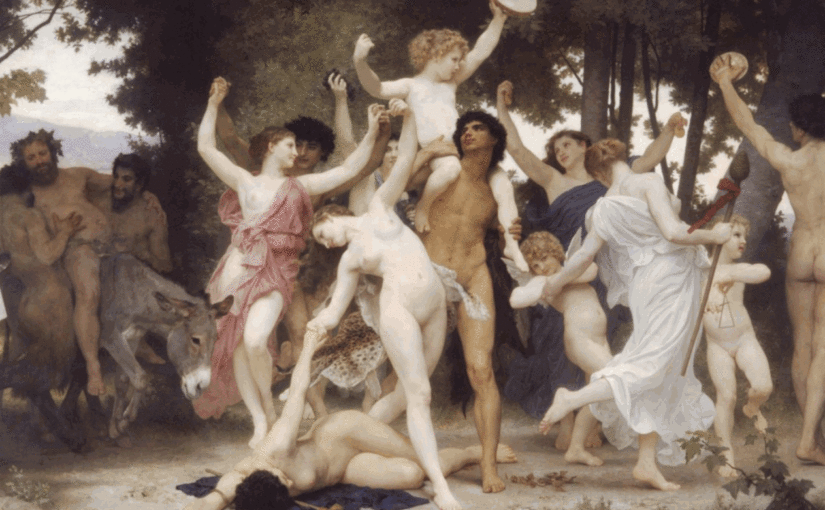

Your time in jail is terrifying, I hope I never have that experience.
My personal experiences with intentional manifestations have a truly Faustian character, and without saying too many specifics, many things I have manifested have had severely negative consequences for others. In fact, this post is quite a synchronicity again as I have just watched the Richard Burton movie Dr. Faustus recently. It doesn’t matter what you experience in life, it is never fully and permanently satisfying. Everything is temporary.
One of my favorite movies of all time is a Jack Nicholson movie called ‘The Passenger’ made in 1973, the film is pure art, one scene after another. It features the stark beauty of Sudan and Spain in the early 70’s. (a must see if you haven’t seen it)
This piece was a work of written art itself. I love the art you depicted, and I own cheap copies of these works/some of the artists. It is all very ironic that your own art/paintings were used against you. Vile and torturous acts resulting in imprisonment. The loss of your belongings
were yet another monstrosity. Thanks to God, the power of good, that
you escaped.
I escaped (we did) from the city to a rural wonderland, and a big blessing for us is that our 2 adult sons followed us here. One found
a wife and has children inherited from her and their own baby. The
older boy is not married, only has part time work. He sold his business
and bought his property outright, so his expenses are low. He has a puppy to combat loneliness.
The politicians in the countries capital are behaving in near unbelievable
ways. I studied for a decade+ on my “self-directed” graduate degree
in economics and political science (really it is history). The quote from
William Casey sums it up, “We’ll know our disinformation program is complete when everything the American public believes is false.”
DC means and ways have filtered down to all of of the 3000+ counties
in the USA. The bosses are gaining ill-gotten gains, and soon the
employees are taking pens, staplers, and copy paper home. The
perpetual war machine will grind forward. How I wish the words of
the Chinese man in your video, “mind your own business” could ever come true. They won’t though because the power brokers apparently
enjoy torturing people, everyone and anyone, everywhere. The history
you shared about the Romans and their enjoyment of torture killings
in arenas was difficult to read. Yet it is true today, enacted via high tech
and horrific bombings of innocents. There will be more, as the blood
lust is never quenched.
I do not care to have hatred or retrobution in my mind. So I won’t,
but I do mourn the destruction of innocents.
Thank you for that, and I am so happy for you and your family. Do not worry too much about your son. He will find a nice girl and they will have a nice family soon enough. Some of us take longer than others. For me, I didn’t get interested in girls until late in the game. Maybe ten years later than my peers. I married at 25 which was about three years later than all my classmates. (I attribute it to university.) Take care, and yes, we see the world inside the USA just collapsing in upon itself. And it is upsetting.
“Why I love this picture is actually unknown. Somehow, and in some deep way it stirs my soul. But I really cannot vocalize what that special something is. It speaks to me in a deep visceral manner.” MM, certainly you do know why you love this picture. It’s the magic of life encapsulated in innocence. A time in life when we lived free (or virtually free) of negative influences. A time when we were visited by fairies, sprites, and other positive forces or spirits. Whether we knew it at the time or not. ( I still retain some of my magical memories of my youth). Curious, that you chose Adolphe Bouguereau for the subject matter. Kinda encapsulates the innocence of child with the love of a caring mother. Is that not what attracts supernatural occurrances in our earliest years when we are at our purest? We are now much older. The scars now show with our battles in this life. You know they are every bit spiritual as well. Don’t you dare give in or give up. Many have gleaned much from your experiences and wisdom. I waited, what, three or four days to read your latest posts because your material is so much more positive and fulfilling than any news or blogs here in the “untied states” at this time. You may be retired, but I believe you still have “unfinished business”. Thank you, MM for everything you lay out here, time after time, post after post. {Publish this comment at your discretion only} Ohio Guy
Ohio Guy this is absolute art. Thank you for your comment. It means a lot to me.
Majestic paintings by a wonderfully prolific artist of his time, equally my heart is reaching out to you recounting your painful memories. Surely our main drive on our beautiful earth is to intend a fairer, kinder world for all life forms.
“Art is a creation that massages our emotions” – I felt compelled to share an experience when visiting the Ballachulish Goddess, an alder wood life sized sculpture now housed in the National Museum of Scotland in Edinburgh. She was removed from her “resting place” in the peat bog in Ballachulish in 1880 which had preserved her wooden body for thousands of years. She was obviously venerated by the ancestors with her sparkling quartzite eyes.
Once exposed to the elements, she had shrunk, warped and cracked and now she is “trapped” in a glass case in her shrivelled state in what I can only describe as an energy prison. I was moved to the point of tears and so wished I could remove her and return her to her original peat grave. Her quartzite eyes told her story. I attach a short piece about her below.
https://www.nms.ac.uk/explore-our-collections/stories/scottish-history-and-archaeology/ballachulish-figure/
In gratitude to your sharing MM, and those of your readers, after all we are in this together
Just hearing this sad tale moves me to tears. Please check out my latest post about my art.
Re Craze religious right in charge of government.
The early settlers of the New World came to escape persecution, religious persecution to be exact. They came to be able to freely practice their religion, away from the clutches of the highly regimented, extremely controlling, state sanctioned church.
Today, the descendents fully evolved to be the very persecutors their forefathers ran away from. Today, the descendents became even more evil than the persecutors their forefathers ran away from. They have committed atrocities after atrocities, never imagined by their forefathers, all in the name of “freedom”.